Western
Heartbreak Ridge: Clint Eastwood excels as the highly-decorated, hard-drinking, tough-talking Marine in the only ‘ԝаr film’ that he made as both actor & director
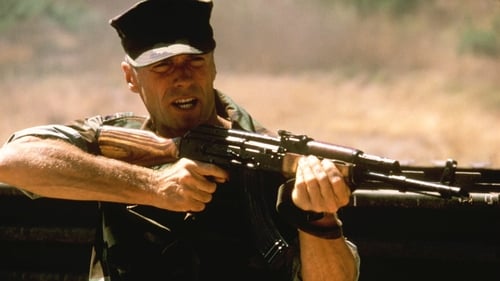
Heartbreak Ridge(1986), produced by, directed by, and starring Clint Eastwood, is a gritty military drama in which Eastwood plays a tough & cynical Gunnery Sergeant who’s close to retirement, and is given a final assignment to whip a rag-tag group of young Marines into shape.
“We’re Marines, sir. We’re paid to adapt, to improvise.”
Though Clint Eastwood has been the ultimate American action-movie-star for the most part of his career, he hardly made many Military\ԝаr dramas. Unlike his much revered and much compared predecessor, John Wayne – who was the pre-eminent macho American star of his times, and has some great ԝаr films to his credit, especially “Sands of Iwo Jima(1949)” – Clint mostly concentrated on Westerns and urban action dramas. He starred in the evergreen WWII adventure “Where Eagles Dare” and the cult WWII comedy “Kelly’s Heroes” in the beginning of his career. Then much much later, in the 2000s, he made “Flags of our Fathers,” “Letters from Iwo Jima” and “American Sniper”- all these films he directed, but did not act in. So, that makes “Heartbreak Ridge(1986)” the only film of Clint Eastwood’s that Clint both acted in and directed. The film also gives Clint his most ‘John Wayne’ role; though Clint has always been considered the true successor to Duke, there’s considerable differences in their screen-persona. Duke, for all his badassery and individualism, was a morally upright team player, even if he’s always the one heading that team. In his films, he always had a group of stock characters (played by his tock company actors) that revolved around him. Which is why he has been the mentor\patriarch\father figure more than any other top tier superstar in American movies. Clint, on the other hand, has always been the maverick and the one-man-army: whether it’s ‘Man with no Name’ or ‘Dirty Harry,’ he’s a lone ԝаrrior, and quite an amoral one at that who doesn’t depend on, or doesn’t like anyone depending on him. That’s the main reason why Clint has not been in Military dramas, where heroes have to be team players, or lead a team. “Heartbreak Ridge” is the one time where he really got into that ‘John Wayne’ mode; he becomes a gruff ‘father figure’ to a bunch of young malcontents, whip them into shape and lead them into battle. The film could be considered a small-scale, comedic and modern version of “Sands of Iwo Jima”, but in typical Clint fashion, this is a ‘R’ rated version of it; for one, the language is non-PC, vulgar and colorful that would make even Duke blush. Clint’s Marine Gunnery Sergeant Thomas Highway has lot of similarities with Duke’s Marine Sergeant John Stryker from “Iwo Jima.”: Initially, both of them are greatly disliked by the men for the rigorous training they puts them through, but later, the men warm up to them, and follow them into battle; both Highway and Stryker has also a nasty habit of getting into violent brawls with their fellow marines. But “Iwo Jima” is a film of larger ambition and done on an epic scale, especially since the film features the soldiers’ involvement in WWII. “Ridge” is more of a comedy-Actioner set in the backdrop of the Marine Corps, with the main battle featured in the film being the ‘invasion of Granada,’ which was hardly a footnote in history. It’s also interesting to note that USS Iwo Jima LPH-2 was the ship that transports Clint and his Marines to Granada in the film.
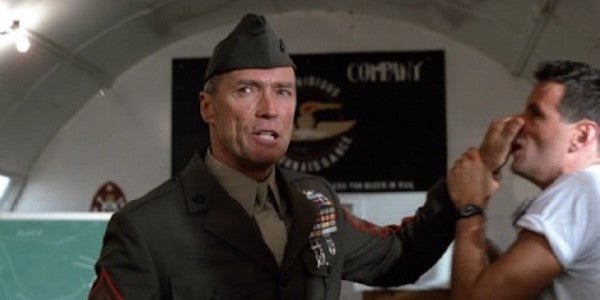
Gunnery Sgt. Thomas ‘Gunny’ Highway (Clint Eastwood) is a hard-nosed ԝаr veteran, who has won helluva lot of medals for his participation in ԝаrs across Korea, Vietnam and Dominican republic. He’s just a year away from retirement, but his incorrigible boozing and brawling is a threat to a honorable exit from the Corps. After his latest drunken rampage that lands him in prison, Gunny is granted his last wish: to rejoin his old unit, the Second Recon Battalion, Second Marine Division. Unfortunately for him, his new CO is the strict, arrogant Major Powers (Everett McGill) who has never seen conflict, and, worse, holds a grudge against Gunny for socking his best pal. Gunny’s given a Recon platoon consisting of a bunch of malcontents to train, one of whom, Corporal ‘Stitch’ Jones (Mario Van Peebles)- a wannabe rockstar, he had the misfortune of meeting on the way- Jones stole Gunny’s bus ticket leaving him stranded on the way to taking charge. Also, Gunny’s platoon leader is the nerdy bookish Lt. Ring (Boyd Gaines). But despite all this, Gunny jumps full throttle into kicking, cursing and growling his squad into shape, even as he, in true ‘Dirty Harry’ style, battles the ineptitude and stupidity of his superiors. After Gunny’s men learn that he had been awarded the Medal of Honor in the Korean ԝаr- for his heroic turn in the ‘Battle of Heartbreak Ridge’, they gain respect for him and close ranks against their perceived common enemy- which would be Major Powers, who goes so far as to arrange things so that the Recon Marines lose in every field exercise to his 1st Platoon. The film’s final act finds Gunny and his men send to (of all places) Grenada to rescue American university students. A major subplot of the film involves delicate matters relating to Gunny’s heart (giving a literal twist to the ‘Heartbreak’ in the title): his attempts to win back his feisty ex-wife Aggie (Marsha Mason), who’s now working as a barmaid and keeping company with a redneck bar owner, Roy Jennings (Bo Svenson). Aggie had left Gunny as she couldn’t take his Marine’s life, as well as his boozing and womanizing. But now nearing retirement, Gunny has an overwhelming desire to reconnect with her, and even takes to reading Women’s magazines to get a better understanding of the female sex. Initially, Aggie is bitter over their failed marriage, but slowly reconciles with Gunny; and at the end, she joins the wives of other Marines in welcoming back Gunny & his men on their return from the successful Granada expedition.
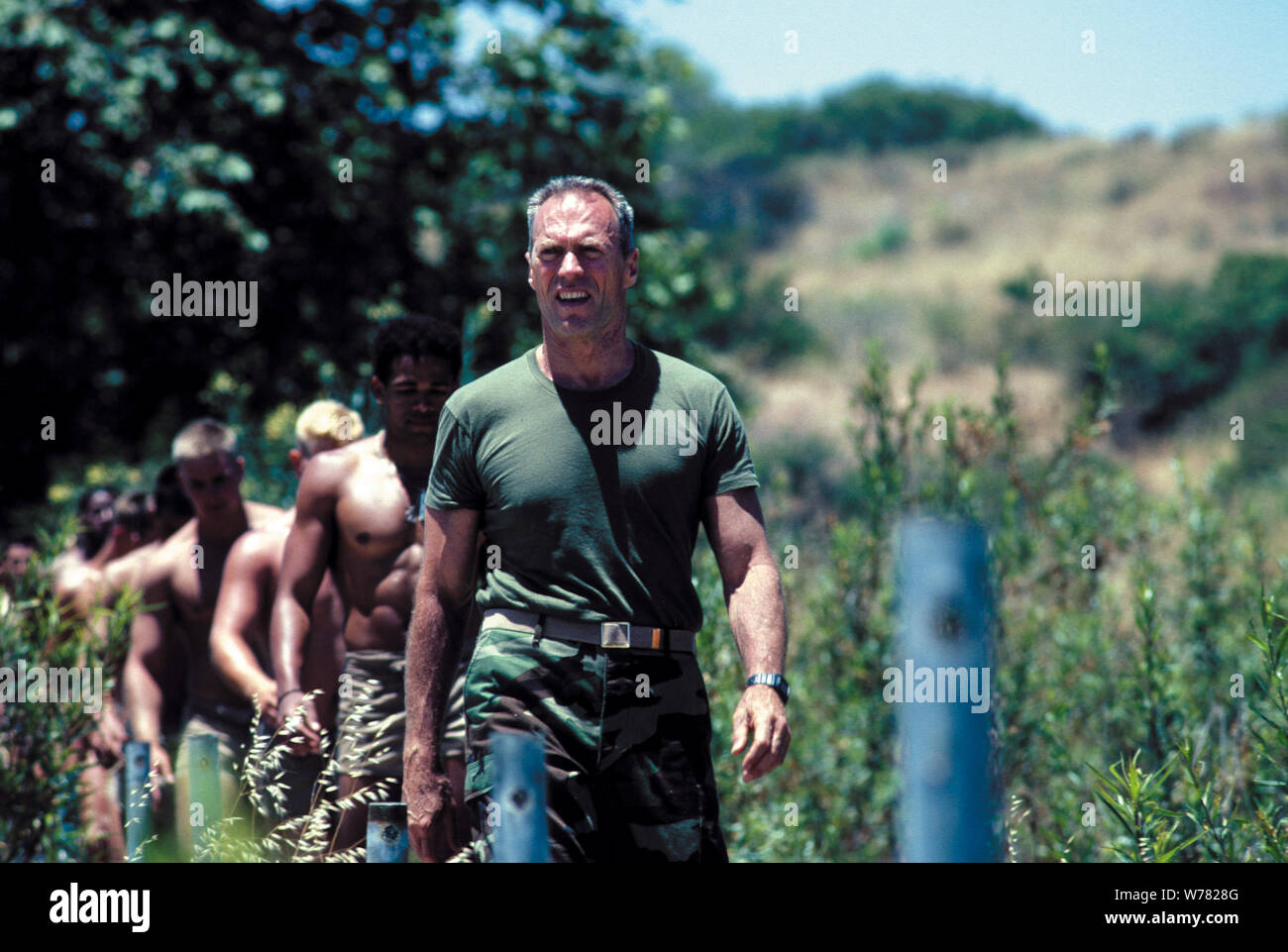
Since the late 1970s, Clint has been alternating between three kinds of films: First, his bread & butter brand of straightforward action dramas, like “Escape from Alcatraz,” “Sudden Impact,” “Firefox” etc.; second, films in which he sends up his macho action-hero image, like “The Gauntlet,” “Bronco Billy,” “Every Which way but we loose” etc.’ and finally, his more ambitious artistic films, like “Honky-tonk Man,” “Bird,” “White Hunter, Black Heart” etc.; all of which culminated in the great ‘Unforgiven,’ which is a mixture of all three- a Clint Eastwood Western, though majorly deconstructed, but serious in tone and artistically ambitious. “Heartbreak Ridge” is quite unique because it’s an attempt to mix the first two types of Clint films from this era. That also makes the film problematic; because it makes his character rather uneven and the narration quite disorganized. And to be honest, taken purely from a filmmaking point of view, “Heartbreak Ridge” is one of Clint’s worst films: the cinematography is terrible- some scenes are so underlit that we cant see much of what’s happening on screen; the editing is raggedy and uneven- the film does not flow smoothly at all and it goes on far too long; and production design is the worst- it looks cheap, far too cheap even by Clint’s economical standards. Audiences of today, who are mesmerized by the effortless, classical grace of Clint’s filmmaking post ‘Unforgiven’ will be shocked by how much of a ragtag filmmaker he’s here.
But what’s most unforgivable is the low quality of action scenes on display here. Whatever one thinks of Clint as a director during those times, even his worst reviewed films like “The Eiger Sanction” and “The Gauntlet” has terrific action sequences, but the action in this film is very tame and unimaginably staged, and is not a patch on the action in his other films; this being the first ‘ԝаr film’ he ever directed, one expected something better from Clint. This is not discounting the fact that the whole ‘invasion of Granada’ looks silly and incredulous.. With a population of about ninety one thousand at the time, it felt like there was no one else on the island except the Marines and a minor opposing force of revolutionary soldiers- referred to as Cubans by the Americans. The only accurate thing about this whole operation is the presence of American medical students. I guess, Clint just wanted to close the film with a big battle to show the capability of his platoon, and he chose the latest one he could get his hands on without going deeply into its details or politics. I have admired Clint’s filmmaking right from his first film, “Play Misty for Me; it was not perfect, but he definitely had an effective technique for telling stories smoothly. “Pale Rider,” which he directed & starred in just before “Heartbreak Ridge” is an extremely well made film. So what happened here is hard to fathom; the film was made during Clint’s ‘Mayor of Carmel’ phase, so that could be one of the reasons for him not putting that much care into making this film; and i guess he considered this to be nothing more than a pure commercial venture, This was not made to win big awards or add prestige to his film cannon, so he just knocked it out in minimal amount of time, cost and effort. The 80s phase was not a very fruitful period for Clint; his films made from the mid 80s onwards till ‘Unforgiven’ were some of his most disappointing ones. He was struggling to break out of being just a popular action star and become a popular artist who does serious work- which he would manage by the 90s. Maybe a purely commercial project like this didn’t hold his interest that much anymore; and he was just doing it to keep the bean counters happy, so that he could get to finance personal projects like “Bird,” which he made immediately after this.

But despite the filmmaking being poor, it’s still a very enjoyable Clint Eastwood star-vehicle due to two reasons: one, writer Jim Carabatsos’ endlessly quotable script, with its flair for marine jargon so baroque that it becomes almost symphonic after a point, despite the crudeness of the language, with its abundance of (homo)sexual innuendos; and second, Clint is in terrific form as star-actor, and gives one of the best acting performances as the cranky, aging Marine. Clint is playing the definitive ‘Clint Eastwood’ tough guy role that looks tailored for his talents as an actor and an icon; a sort of ‘Dirty Harry’ of the Marine Corps, he’s the man’s man in every situation, and like a true Marine he adapts, improvises and overcomes anything that’s thrown at him, whether it’s the undisciplined marines he’s forced to train and lead, or the inept, arrogant superiors he’s forced to tangle with time and again. Right from his introduction scene in the prison cell he has us hooked – where first we only hear his voice, and this time he has a particularly harsh voice, like George C. Scott’s from “Patton,” because of an injury to his vocal chords, the scar is prominently displayed on his neck. Gunny is recounting one of his daring military exploits to prisoners gathered around him; and then he gets into a fistfight with a hulky prisoner who challenges his bravery; a fistfight which he naturally wins. That the hardened veteran earned the respect of tattooed bikers during his little prison jaunt speaks volumes about his masculine charisma. This introduction scene maybe no way original- it’s very similar to his introduction in “Joe Kidd (1972),” right down to the meeting with the judge in the courthouse, where he’s booked for urinating on a police car; but it’s still a striking introduction for the macho star and the tough-guy character he’s playing. And the script gives him plenty of one-liners which he delivers in a more intimidating and forceful style than what we have come to expect from his ‘Dirty Harry’ films. Come to think of it, Clint’s ‘Gunny’ in the film lies somewhere between his ‘Dirty Harry‘ and his Korean ԝаr-veteran ‘Walt Kowalski’ from “Gran Torino(2008).”
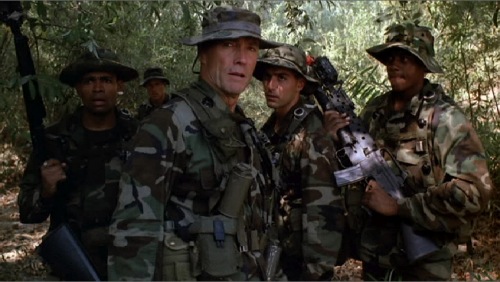
The only issue with the character is the attempts to soften him (or send him up) with those portion dealing with his wife, and his attempts at reigniting their affair- that has him reading ‘Harper’s Bazaar’ and other magazines. Marsha Mason is a very good, and very good looking actress, and she spars with Clint with passion and vigor; and I feel that Clint was once again going for that ‘John Wayne’ thing with this plot point- an attempt to replicate the fiery chemistry between Duke and Maureen O’Hara in countless films, especially the Cavalry Western, “Rio Grande.” But once again, Clint’s screen persona in a tough-guy action picture does not give in naturally to romance, even of the feisty kind, as John Wayne’s does. The result is that, though done with good intentions, the whole romantic subplot feels very forced and gimmicky. Macho Clint reading Women’s magazines, then almost seducing his ex-wife, only for her to realize his ‘game’ and kick him out of the house makes for chuckle worthy scenes, but it kicks the character and the film out of shape. This ‘sending up’ aspect can also be noticed in the depiction of the ragtag nature of the platoon, the scenes of conflict between Gunny and his trainees, and the portrayal of the arrogant senior Marine officials- all of which are exaggerated to unrealistic and cartoonish levels. This stands in complete contrast to the final act detailing the invasion, and much of Gunny’s characterization- which is straight and well developed. The star, character and film would have been better served if they had kept it very straight, and made it a very straightforward masculine military drama from beginning to end.

At least Clint Eastwood, the director, selected a really good supporting cast; though the screenwriter has filled the film with ‘ԝаr movie’ stereotypes, they are pretty entertaining and colorful. Really good in their roles are Arlen Dean Snyder as Gunny’s best friend, Sergeant Major J. Choozhoo, and Eileen Heckart as a Marine Corps widow who’s also Gunny’s friend who feeds him information on his ex-wife. Mario Van Peebles as the wannabe rockstar among the Marines is the most colorful of them all, and whose cocky, irritating character seems to be modelled after the ones played by reigning African-American superstar, Eddie Murphy. The film was made with the support of the Marine Corps, (that’s after the Army had refused to support the film, and hence the lead character was changed to a Marine to secure the help of the Corps) but after watching the finished film, the Corps disavowed it; they were shocked by the crude language, and several inconsistencies in the training and behavior of the Marines depicted in the film. But the audiences didn’t mind, they made it a reasonably big hit for Clint- to the tune of $120 million worldwide. Commercially, the film seems to have benefitted from arriving in the middle of a series of successful military-training themed movies in the 80s, like “Stripes,” “Officer and a Gentleman,” “Full Metal Jacket” etc. Finally, for me, a die-hard Clint Eastwood fan, “Heartbreak Ridge,” though very far from being a top-tier Clint film, is still an enjoyable film, thanks to the punchlines and the presence and the performance of its iconic star, who gives one of his richest performances- I rank it as his best performance (or at least my favorite performance) from the 80s alongside “Bronco Billy” and “Tightrope.”
You may like
Western
Steve McQueen: We didn’t get along,Brynner came up to me in front of a lot of people and grabbed me by the shoulder
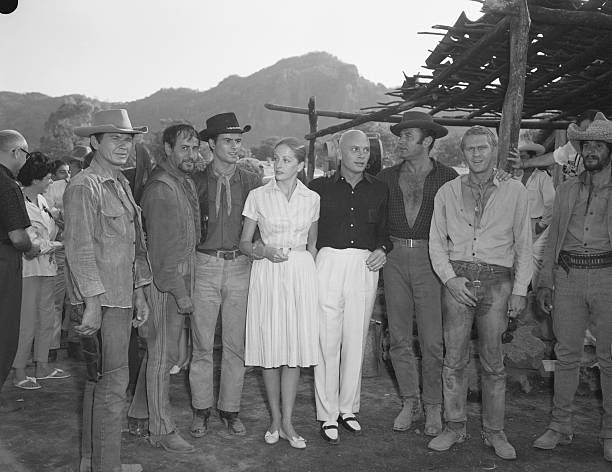
YUL BRYNNER famously feuded with everyone from Steve McQueen to Ingrid Bergman, with an ego to match The King of Siam. His temper was legendary, his affairs were numerous – with men and women – and he famously flaunted his body in nude pictures. Even the reason behind his famous bald head was part of the man and the myth.
Whether thundering across the screen in The Magnificent Seven or scowling at the world in the King and I, Brynner was a unique screen presence. The self-proclaimed “Mongolian” star fought his way up from being an immigrant circus performer and loved to elevate himself to epic levels. When asked about his various conflicting dates of birth, he grandly replied, “Ordinary mortals need but one birthday.” He liked it to be known that he prepared breakfast in a silk kimono, other stars commented how he was “never far from a mirror” and his on-set demands and dramas were legendary. But then, his whole life had been extraordinary, from nearly dying in a youthful trapeze accident to numerous bisexual affairs along the way to becoming more famous than the Siamese king he played so many times on stage and screen.
Brynner’s iconic look was even a calculated ploy. He did not lose his hair but kept his head shaved because he enjoyed the attention he got for it when he debuted The King and I on Broadway in 1951. After that, he also demanded that he was never photographed with another bald man so that he always stood out in pictures.
The musical made his name but he chafed at taking second billing behind Gertrude Lawrence. When she died in 1952, he notoriously wept – but with joy because it meant his name would, at last, be top of the bill.
It was somehow fitting that he died just on October 10, 1985, just a few months after performing The King and I on Broadway – his 4,625th time taking the stage in his regal, spotlight role. For an actor who was obsessed his whole life with having top billing, he would have been far less pleased to know that he passed away on the same day as Orson Welles, and so was overshadowed in his final hour.
Brynner had grafted hard for his success and fought even harder to keep it. Raised in Beijing and abandoned by his father, his mother fled with her children to Paris in 1932, where talented acrobat Yul became a trapeze artist with the Cirque d’Hiver.
A horrifying fall in 1937 broke many bones in his body and left him unable to walk for eight months. He turned his attention to the stage and set sail for America in 1940.
During that first Hollywood decade of bit parts and odds jobs, he had an affair with handsome heartthrob Hurd Hatfield, who starred in 1945’s The Picture of Dorian Gray, as well as 1961’s El Cid opposite Charlton Heston.
Married four times, he also had affairs with men and women alike, from Marlene Dietrich, Joan Crawford and Judy Garland to artist Jean Cocteau.
Brynner’s enormous success on Broadway brought him back to Hollywood as a star and he was determined to impress in every way. His obsession with his own appearance meant that he increased his work-out regime when he learned he was playing Pharaoh Ramses II opposite Heston’s Moses in 1956’s The Ten Commandments, so as not to be overshadowed by the strapping actor.
This meant he was in phenomenal shape when he starred as King Mongkut of Siam in the film version of The King and I that same year, going on to win the Best Actor Oscar.
His impressive physique was also bared for all to see when pictures surfaced of a naked shoot he had down with gay photographer George Platt Lynes.
In turn, Brynner was an accomplished photographer himself, taking noted snaps of famous friends like Frank Sinatra, Elizabeth Taylor, Anthony Quinn, Sophia Loren, Mia Farrow and Audrey Hepburn.
From the mid-1950s he instantly became established as a major Hollywood star, with roles, salary and ego to match. Unfortunately, he did not have the corresponding physical height, which lead to two of his most infamous showdowns with fellow Tinseltown legends.
Bergman was over an inch taller in flat feet than his own 5ft 6½in. When the Swedish actress politely asked him if he would like to use any props to stand on, Brynner hissed back: “I am not going to play this on a box, I’m going to show the world what a big horse you are.” Horselike or otherwise, the actress went on to win her own Oscar for that role, her second of three in total.
Brynner’s behaviour hit new “heights” on the 1960s sets for The Magnificent Seven, particularly centering on a running battle with co-star Steve McQueen, who wasn’t particularly tall himself at 5ft 8in.
Whenever they were shooting outside, Brynner would scuff the earth and dirt into low mounds for him to stand on. McQueen, in return, would causally flatten them as he walked past.
Increasingly amused and irritated by Brynner’s behaviour, McQueen would also play with his hat or belt whenever his co-star was talking in a scene to subtly pull focus. All those iconic shots of the square-jawed
star taking off his hat to shade his face or using it to scoop up water from river were mainly shameless scene-stealing tactics.
He later said: “We didn’t get along. Brynner came up to me in front of a lot of people and grabbed me by the shoulder. He was mad about something. He doesn’t ride well and knows nothing about guns, so maybe he thought I represented a threat. I was in my element. He wasn’t. When you work in a scene with Yul, you’re supposed to stand perfectly still, 10 feet away. Well, I don’t wBrynner even hired an assistant with the sole job of monitoring McQueen’s misdemeanours and counting how many times he fidgeted during scenes, playing his hat, belt or gun. The antics increasingly infuriated the rest of the cast, leading to considerable friction on set. Decades later, dying of cancer, McQueen called to apologise. Brynner forgave him but Charles Bronson never did.
That said, Brynner’s own notorious behaviour never changed. In his early days of stardom, he insisted a special lift was installed at the Broadway theatre where The King and I was playing. Not just for him, but big enough for his white limousine – so he could drive in and out without being bothered by fans.
In 1965, he starred with Marlon Brando in the World War II ocean-bound action thriller Morituri and managed to eclipse his co-star by demanding a landing pad be built onboard the ship where they were filming, so his private helicopter could fly him back at the end of each day while his castmates were left, literally, all at sea..
PROC. BY MOVIES
Western
Donald Sutherland : I was lying on my back on the bed when Jane came out of the bathroom
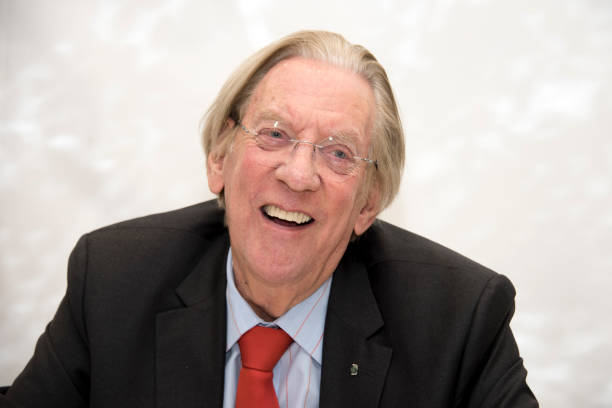
Donald Sutherland still remembers an intimate moment they shared fifty years ago . He said she “seduced” him but he was left “eviscerated” when their passionate two-year affair suddenly ended.
While filming Klute in 1970, Sutherland fell in love with fellow star and activist Jane Fonda, even though both were married at the time. In the 1960s and 70s he was at the heart of Hollywood activism, alongside an on-screen career that included provocative and seminal films like Don’t Look Now and The Invasion of The Body Snatchers. They were matched body, mind and soul. For the next two years, they were together at the forefront of Hollywood support for the civil rights movement and opposition to the Vietnam War. The pair were just as passionate in private and Sutherland still dwells (often in no holds barred detail) on their intimate moments together.
Klute started filming in 1970. Fonda had been together with husband Roger Vadim, who directed her in 1968’s Barbarella, since 1963. When rumours started spreading in 1970 that they had separated, her official spokesman quickly denied it.
However, Sutherland later described how it was his beautiful co-star who made all the moves on him: “We’d already been cast but had not started shooting, and one day, she made it very clear, via a somewhat provocative suggestion, that I should come home with her. And I just said… Ok.’”
It would mark the end of the actor’s own second marriage to Shirley Douglas, which had produced twins Kiefer and Rachel
Kiefer revealed in 2014 that they had never discussed the affair but he imagined his father would say: “‘I fell in love.’ I understand that. People do. And when they’re falling in love, they believe in everything so strongly and passionately, this kind of heightened experience, that it’s very hard to judge somebody for it.”
His father frequently and famously has talked about the love and the lust, famously declaring: “She had, at the time, the most beautiful breasts in the world.”
Apparently, he followed that description with an anecdote so explicit it was not suitable for print. He did, however, wax lyrical in another interview about a naked moment that still has the power to stop his breath decades later.
Sutherland told GQ: “I was with Jane Fonda at the /Chelsea Hotel in 1970, maybe ’71. It was a room with a big bed and, to the right, four or five stairs to a landing that led to the bathroom. There was a little oval window on the landing and there was a street light shining through that window though it seemed more like moonlight, so maybe it was the moon, I like to think it was the moon.
“I was lying on my back on the bed when Jane came out of the bathroom. She, too, was naked, and when the moonlight caught her perfect breasts I stopped breathing. Everything stopped. And then it started again. Now, when I see it in my memory, I stop breathing again.”
It’s easy to believe. The actress has maintained her extraordinary figure through the decades, although this year she finally allowed her natural grey hair to shine.
The affair was passionate and intense, although Fonda has been less vividly ‘descriptive’ over the years.
She said in her autobiography that he had, “Something of the old-world gentleman about him.” The actress added that she found his “rangy, hangdog quality and droopy, pale blue eyes especially appealing.”
Alongside both their successful Hollywood careers, the pair performed together at benefits for soldiers who opposed the Vietnam War and found themselves on CIA watchlists.
Although they seemed perfectly matched, the affair would suddenly burn out as abruptly as it started – leaving Sutherland devastated.
He said: “We got together shortly before we made Klute and then we were together until the relationship exploded and fell apart in Tokyo. And it broke my heart.
“I was eviscerated. I was so sad. It was a wonderful relationship right up to the point we lived together.”
However, in 1972, Sutherland married French Canadian actress Francine Racette, after meeting her on the set of the Canadian pioneer drama Alien Thunder. It remains one of the longest and most stable marriages in Hollywood, and has produced three sons – Rossif Sutherland, Angus Redford Sutherland, and Roeg Sutherland.
After three high profile marriages to Roger Vadim, activist Tom Hayden and media tycoon Ted Turner, Fonda dated music producer Richard Perry until 2017 and has said she is now happily single.
The actress has also battled cancer three times. Last week she announced that, after undergoing multiple rounds of chemotherapy to treat Non-Hodgkin lymphoma, her cancer is now in remission.
PROC. BY MOVIES
Western
Gene Hackman gave his first interview in a decade, telling The Post about his “checkered career of hits and misses
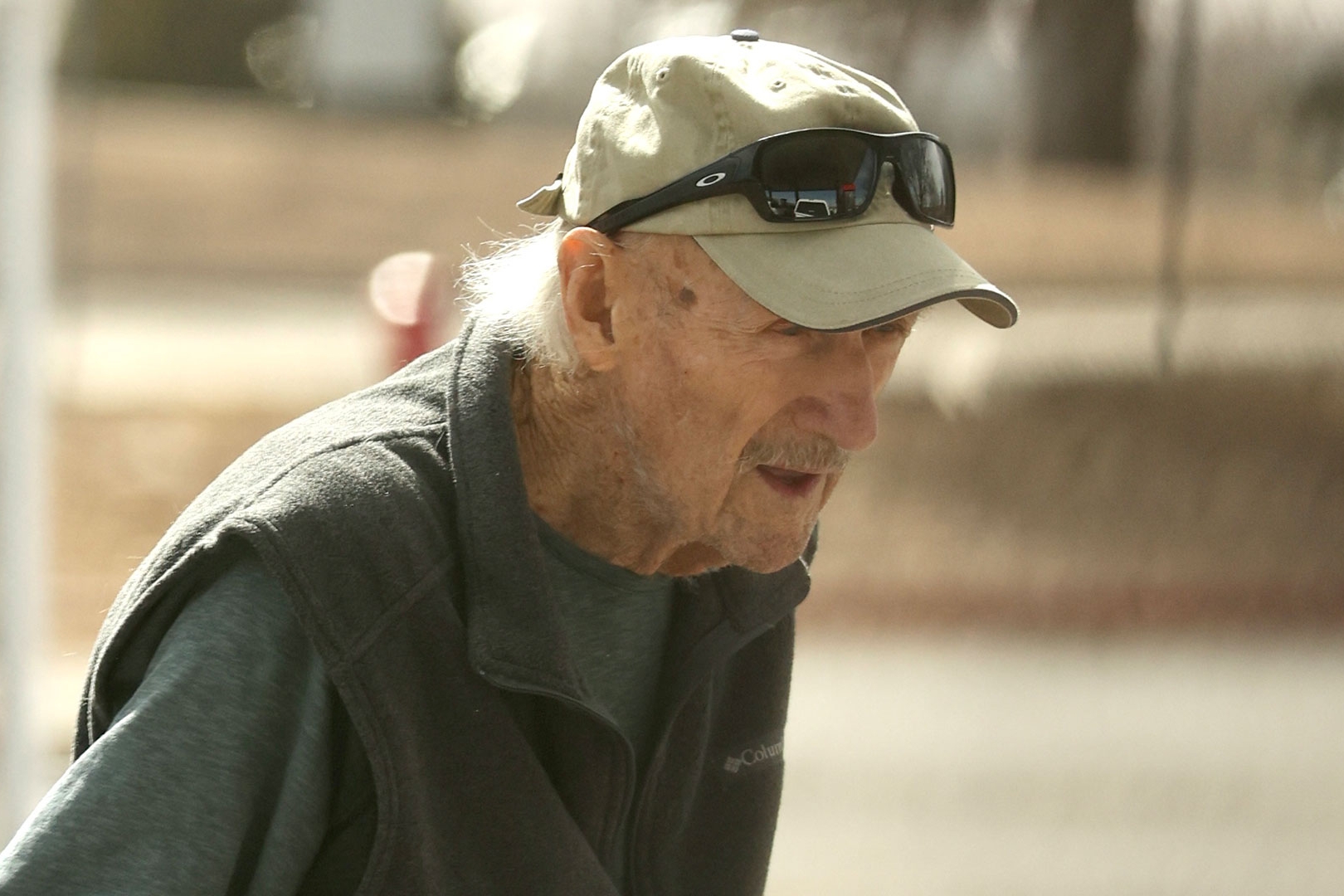
Hollywood legend Gene Hackman proved he’s still in tip-top shape as he performed yard work at his ranch in Santa Fe, New Mexico, on Sunday.
The “Unforgiven” actor — who celebrated his 93rd birthday in January — looked fit and healthy as he brandished a shovel at his private estate.
Earlier in the day, the two-time Oscar winner was spotted fueling up for physical labor at a local Wendy’s, where he ordered a meal at the drive-thru.
Hungry Hackman chowed down on his chicken sandwich in the fast food franchise’s parking lot before pumping gas at a nearby station.
It was a rare sighting of the reclusive and retired star, who was last seen on-screen in the 2004 comedy “Welcome to Mooseport.”
Despite being one of Tinseltown’s powerhouse performers — appearing in classics such as “The French Connection,” “The Conversation,” “Superman,” “Hoosiers” and “The Royal Tenenbaums” — Hackman has long shunned the bright lights of Hollywood.
The father of three, who has lived in New Mexico with his pianist wife, Betsy Arakawa, for decades, also abstains from giving interviews — except to The Post.
In late 2021, Hackman gave his first interview in a decade, telling The Post about his “checkered career of hits and misses.”
Speaking on the 50th anniversary of “The French Connection” — the hit film for which he won his first Best Actor Oscar, in 1972 — the star stated: “The film certainly helped me in my career, and I am grateful for that.”
The down-to-earth actor added that he wasn’t a fan of rewatching his own flicks and hadn’t seen the classic crime caper since 1971.
“[I] haven’t seen the film since the first screening in a dark, tiny viewing room in a post-production company’s facility 50 years ago,” he told The Post.
Hackman — who previously resided in ritzy Montecito, California — has lived in Santa Fe since the 1980s.
The actor is also an architect and designer who has helped create more than 10 homes — including a New Mexico manse that was featured in Architectural Digest.
Since his retirement from Hollywood, the star also busied himself writing novels, including the 2013 police thriller “Pursuit.”
In 2012, the actor was struck by a pickup truck while riding his bike in Florida. He was airlifted to the hospital and made a full recovery.
PROC. BY MOVIES

How Maureen O’Hara Broke Her Hand During Iconic Scene With John Wayne

Clint Eastwood Refused to Take Directorial Credit for 1 Movie Despite Taking Over the Chair Due to His Frustration With the Writer

Inside John Wayne’s Decades-Long Relationship With Maureen O’Hara
Trending
-

 Entertainment7 months ago
Entertainment7 months agoJohn Wayne’s son speaks on military service, Hollywood life and his dad, ‘The Duke’ – My Blog
-

 Entertainment7 months ago
Entertainment7 months ago40 Legendary John Wayne Quotes – My Blog
-

 Entertainment8 months ago
Entertainment8 months agoNew biography reveals the real John Wayne – My Blog
-

 Entertainment9 months ago
Entertainment9 months agoWhy one POPULAR ACTOR was FIRED from THE SONS OF KATIE ELDER and lost his career as a result! – Old western – My Blog
-

 Entertainment7 months ago
Entertainment7 months agoHow Maureen O’Hara Broke Her Hand During Iconic Scene With John Wayne – My Blog
-

 Entertainment8 months ago
Entertainment8 months agoRio Lobo (1970) marked the last collaboration between John Wayne and Howard Hawks. – My Blog
-

 Entertainment8 months ago
Entertainment8 months agoDid John Wayne really have a good time filming 1972’s The Cowboys? – My Blog
-

 Entertainment7 months ago
Entertainment7 months agoJohn Wayne and the ‘Bonanza’ Cast Appeared in This Epic Coors Light Commercial – My Blog















